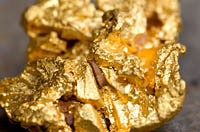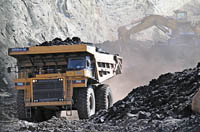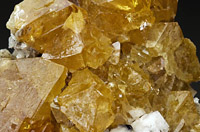
"... the greatest value is added by the geologist who starts with nothing other than some ideas and goes out into the desert and finds an orebody" 1 |
ESS 345 Glossary of Economic Geology Terms (an ESS 345 class effort)
Anhydrite
Antimony
Anthracite
Banded Iron Formation (BIF)
Barite - A barium sulfate (BaSO4) mineral that is white or clear in color, and is the primary source for barium. Barite is mainly used as a weighting agent for drilling fluid, but has other uses as a pigment, weighting agent, and to block x-ray and gamma ray emissions in hospitals and power plants.
Base metals
Biomarker are any of suite complex organism compounds composed of carbon, hydrogen and other elements such as oxygen, nitrogen and sulfur, which are found in crude oils, bitumens, petroleum source rock. They are called "molecular fossils" because they retain all or most of the original carbon skeleton of the original natural product. Biomarkers are used to make oil-source correlations and to infer characteristics of the source rock that generated the oil to reveal (1) the relative amount of oil-prone vs. gas-prone organic matter in the source kerogen, (2) the age of the source rock, (3) the environment of deposition as marine, lacustrine, fluvio-deltaic or hypersaline, (4) the lithology of the source rock (carbonate vs. shale), and (5) the thermal maturity of the source rock during generation. For example, 30-norhopanes is a biomarker parameter for carbonate source rock that has high in carbonate-sourced oils.
Boehmite (γ-AlO(OH))
-is an aluminum oxide hydroxide mineral and the main constituent is bauxite ores
-if found mainly in tropical laterites and bauxites
-can also be found in volcanic pegmatites and hydrothermal alteration of corundum and nepheline
-useful applications are in catalysts, polymer additives, coatings, and sol-gel ceramics
Bornite
Cap rock - A harder, more resistant layer of rock that overlies less resistant rock types. Cap rock can also be used to describe a nonpermeable layer of rock that can trap oil, gas, or water.
Cassiterite is a tin oxide mineral SnO2and it is the chief tin ore throughout ancient history and the most important source of tin. It can be found in alluvial or placer deposits containing the resistant weathered grains. It is used to produce tin cans for food container, electronic industry, an alloy for bearing metal and as an alloy in metallic coatings. Inorganic compounds of tin are used in ceramics and glazes. Organic compounds of tin are used in plastics, wood preservatives, pesticides and in fire retardants. Cassiterite has high economic value because it has advantageous combinations of a low melting point, malleability, resistance to corrosion and fatigue, and ability to alloy with other metals. It is also non-toxic and easy to recycle. It occurs in both primary and secondary deposits. Primary deposits are associated with granite intrusive and secondary deposits derive from the weathering and erosion of primary tin deposits.
Chalcophile is a chemical substance that would rather react with sulphur instead of oxygen. Chalcophile elements include Ag, As, Bi, Cd, Cu, Ga, Ge, Hg, In, Pb, Po, S, Sb, Se, Sn, Te, TI and Zn. Although no chalcophile element is of high abundance in the Earth's crust, chalcophile elements constitute the bulk of commercially important metals. This is because, whereas lithopile (oxygen-loving) elements require energy-intensive electrolysis for extraction, chalcophiles can be easily extracted by reduction with coke and chalcophiles. These greatest enrichments occur in high plateau like the Tibetan Plateau and the Bolivian altiplano where large quantities of chalcophile elements have been uplifted through plate collisions. A side effect of this in modern times is that the rarest chalcophiles (like mercury) are so completely exploited that their value as minerals has almost completely disappeared.
Chalcopyrite (CuFeS2)
-a copper iron sulfide mineral, brassy and yellow in color
-is present in volcanic sulfide ore deposits, formed by deposition of copper during from hydrothermal vents, or formed in porphyry copper deposits crystallizing in a magmatic system
- the copper in chalcopyrite makes it useful in many objects such as pipes, circuits, coins, brass, ammunition, etc
Coal
Connate - or connate water is fluid that is trapped in the pore spaces during the initial deposition of sediments. These fluids contain not only water, but many other dissolved ions that can be precipitated during the lithification process or leached into the surrounding material. The precipitation can lead to reductions in permeability and porosity creating reservoirs of water or trapping fossil fuels. Connate water is particularly important in oil and gas sands because they can be studied to help better interpret the depositional environment of the area and help create a more comprehensive view of the play.
Crude oil
Crystal Fractionation - Magmatic differentiation resulting from the floating or settling, under gravity, as minerals crystalize out of melt at different temperatures as a ingenious body cools.
Diamond
Darcy's Law - A law formulated by Henry Darcy in 1856 that describes the rate at which a fluid flows through a permeable medium. The law states that this rate is directly proportional to the drop in vertical elevation between two points in the medium and indirectly proportional to the distance between them.
Drive
Endogenetic is a concentration caused by interior Earth processes, like magmatism or metamorphism.
Epithermal The process by which ore deposits are concentrated by warm fluids at relatively shallow depths. Refers to veins of silver and gold being formed within the Earth's crust from rising hot solutions.
Exogenetic is a concentration caused by exterior Earth processes, like sedimentation or weathering.
Evaporite
Ferrous Metals
- Fe2+ or Fe3+ oxidation state iron metals
- Iron is found in the form of magnetite, hematite, goethite, siderite, or limonite
- Ferrous Metals mainly contain iron and have magnetic properties
- Has many uses in construction, in electronic appliances, in vehicles, in containers, hardware items, etc
Fluid inclusion
Gangue - The commercially worthless material that surrounds, or is closely mixed with, a wanted mineral in an ore deposit. Gangue differs from overburden, which is the waste rock or materials overlying an ore or mineral body that are displaced during mining without being processed. The separation of mineral from gangue can be a complicated process. For example, galena an ore of lead, is usually found in large pieces within its gangue, so its does not normally need extensive processing to remove it. Recently, gangue also is reused for power generation to avoid the environmental pollution.
Goethite or Hydrated Iron Oxide FeO(OH), is an important ore of iron.
Gold
Gossan
Gypsum
Hematite Although other minerals, such as magnetite, have higher iron concentrations, hematite is so much abundant that is easily the most economically important iron ore. In North America, over 90% of our iron comes from hematite deposits and without hematite, steel-based industry society could not exist. The use of iron and steel throughout the industrial world is so prevalent. Hematite is a common ore of iron because it contains about 70% iron. Once mined, the iron from the hematite is then mixed with other elements in order to make it into steel, the most common use of iron ore. Processed hematite produces iron, which comes in many forms and is used in a variety of different ways. In its powdered form, iron is used as a chemical catalyst and in magnets. Radioactive iron has medicinal uses. Iron is also combined with other products make steel, which is used in thousands of products today, ranging from bridge construction to kitchen appliances. Hematite is mined, melted down, and used as an iron ore for various metal needs.
Hydrofracture or fracking, is used to reestablish wells that are not providing enough water. Water is pumped at high pressure and volume into a specific part of isolation between the static level and fracture system. This pressure of added water creates fractures in the rock that open and spread creating connections between the low production wells and areas that are water-bearing to increase the failing wells water production.
Hydrothermal
Kaolinite
Kerogen
Kimberlite
Lignite or coal, is formed from the partial decomposition of plant material from high pressure and temperatures with in the Earth's crust.
Longwall Mining
- a form of coal mining that involves a long single slice of coal to be mined
- 3-4 km long by hundreds of meters wide
- drills, conveyor belts, and an electric cutter are primarily used to directly extract coal from the wall of an underground coal mine
- long wall mining is extensively used as a final stage for room and pillar mines
- the old pillars are removed and collapsed and remined from the collapsed coal this makes up for 10% of the coal mining industry and is responsible for 25% of coal mining deaths.
Maceral
Magnesite
Metallogenesis
Metallurgy
Millerite - A nickel sulfide (NiS) mineral that is brassy in color with a metallic luster, typically has acicular habit, and is a very important ore for Nickel when found in higher concentrations.
Neutron Log
- Neutrons from an isotopic source are measured at one or several detectors after they migrate through material in a borehole.
-Neutron logs can help determine, porosity/lithology, delineate porous formations, detect gas, and estimate shale content
- This is useful for underground mining or gathering information about the type of resource
Oil maturation
Oil shale
Ore grade The fraction of the required element contained in the ore from which it is extracted. The more dilute is the ore, the greater is the quantity of rock that must be excavated, crushed, and treated to extract 1 kg of metal. Low-grade ore does not contain a very high proportion of valuable minerals. The term could also be applied to richer ores containing large amounts of undesirable impurities, arsenic for example. High-grade ore contains a lot of the mineral or metal that you want to extract.
Pentlandite
Phosphorite
Placer mining is the mining of alluvial deposits for minerals. It is frequently used for precious metal deposits such as gold and gemstones because they are often found in alluvial deposits. Since gems and heavy metals are denser than sand, they tend to accumulate at the base of placer deposits One of the simplest methods is panning. Mined ore is placed in a large pan, combined with a generous water, and agigated so that the gold particles settle to the bottom.
Porphyry is an igneous rock with larger grains floating in a fine- grained groundmass.
Primary Migration - is the movement of petroleum from the fine grained source rock to a reservoir rock through the interconnected vessels and pores in the source rock. At higher pressures it is thought that smaller hydrocarbon molecules are more soluable in the connate fluid and migrate through the pores with the fluid. The full migration process is still not totally understood
Pyrite
Pyrolusite
Pyrrhotite
Resources vs reserves
Rhodocrosite
Sabkha
Salt dome
Skarn
Sphalerite
Stock - An igneous intrusion that is no more than 100 km2 exposed at the surface. Only size differs stocks from batholiths, most stocks are considered to be the cupolas of batholiths, or feeder vents to former volcanoes
Stope - A process used in hard rock mining to access ore underground. The ore is mined and removed leaving a large cavern known as a stope. The stoping process is used when a deposit is too costly to reach by open pit mining or when that deposit is in an isolated vein. Stoping creates a series of steps that can either be left open or backfilled with tailings from the level above depending on the competency of the county rock the ore body is confined by. There are many different types of stoping which usually just refer to the direction of the mining process.
- Underhand stoping goes from the top of the deposit down and uses gravity to aid in the liberation of ore from the rock body. Commonly done in the past when hand tools were used
- Overhand stoping starts at the base of the ore body and goes up to the top. It is more prevalent today with modern tools and explosives.
- Combined stoping starts at the top and bottom and works toward the middle
- Breast stoping is usually used on a horizontal deposit and typically leaves large room and pillar complexes.
Supergene
Tailings are the waste streams produced in mines from the extraction of a desired ore product. They consist of ground rock and process effluents, or discharge.
Tar sand
Tennantite is a blackish lead-gray mineral, closely related to tetrahedrite. It is essentially a sulphide of arsenic and copper. The tetrahedrite-tennantite group is an important ore of copper, silver, mercury and antimony. It also can be used in alloy reactions requiring either a copper-bearing ore or a silver-bearing ore, but will only be used as a silver ore if not other silver ores are available.
Tetrahedrite is a sulfide mineral and forms a solid solution series with the mineral tennantite, Copper Arsenic Sulfide Cu12As4S13 and is used as an ore for copper and as a minor ore of silver.



